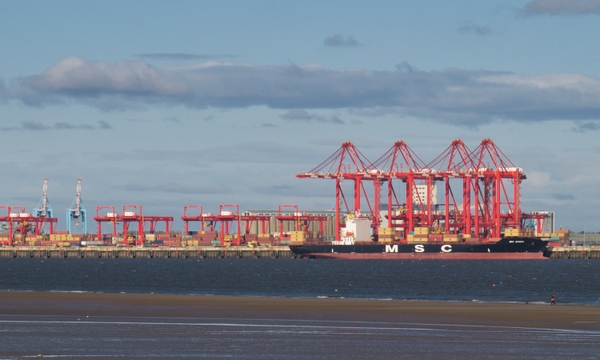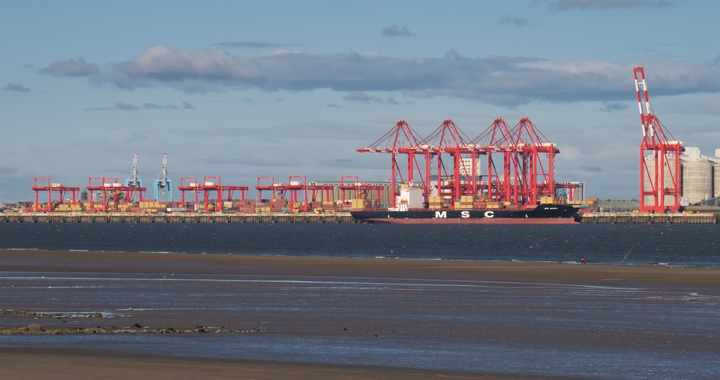Top 5 Largest Ports in the UK


When taking a look at the countries with a long history of maritime activities, we’d be remiss not to include the United Kingdom in the list. The UK houses some of the world’s largest and also busiest ports, being a critical area for the global transport of goods. In fact, ports in the UK contribute over $57 billion to the country’s economy.
In this article, we rank the five largest British ports, according to annual TEU volume and number of cargo. Because of their large annual traffic, these large ports are also some of the busiest in the booming UK maritime industry.
1. Port of Immingham
More popularly known as the Immingham docks, the Port of Immingham is the largest port among the UK ports, having moved over 55.6 million tonnes of cargo in 2018 and 55.1 million tonnes in 2019. The Immingham port is one of the leading port complexes in the UK, considering its position as a major port on the East Coast.
The Port of Immingham contributes billions of dollars to the country’s economy each year, thanks to its vast shipment of goods and services, including:
- Agribulks
- Automotive
- Construction
- Containers
- Bulk Energy
- Liquid Bulk
- Rail Freight
- Offshore Wind
- Project Cargo
- Ferries
- Steel and other metals
The Immingham port constitutes an important part of the supply chain in the United Kingdom. The port was under development from 2019 to 2020, in an effort to expand its capacity and cut emissions. The project, referred to as “Project Pilgrim,” was dedicated $42 million to achieve its goals.
2. Port of London
While only second in the list of largest main ports in the UK, the Port of London is Britain’s largest container port and is the one with the highest growth rate in terms of annual traffic. In 2018, it handled over 53.2 million tonnes of cargo, which is a 7% increase from its traffic the previous year. Being a large shipping port in its mother country, the Port of London is also one of the busiest ports in the world.
Located in the country’s financial capital, the London Sea Port is a crucial part of London’s economy, maximizing its capacity to handle millions of tons of cargo, 1,500 cranes, and 60,000 ships per calendar year. Its contribution to the country’s development is also owing to its River Thames facility, which is in charge of carrying 60% of the total goods in the country’s inland waterway network.
The London Port can handle all types of cargo, making it a very versatile port. However, its most common goods include:
- Containers
- Hazardous cargo
- Food
- People
- Machinery
It is predicted that the Port of London will be able to handle up to 80 million tonnes of cargo a year by the year 2035 after the river lane developments come into effect. Currently, the London port connects the city to the rest of the UK through the best road, rail, and sea links.
Part of the large UK shipping ports list, The Port of Southampton has always been a hub for passenger and cargo movement in South England. It has quite the portfolio, being one of the UK’s largest and busiest ports. For cargo, it carries over 34.5 million tonnes yearly. For containers, it has an annual throughput of 1.9 million TEUs and has the largest container port in the UK. In only a day, the Port of Southampton carries 23 containers for dispatch to and from the ports of England, Midlands, East Coast, North West UK, and Scotland.
A port in England that serves as the UK’s gateway to the rest of Europe and the world, the Port of Southampton also has its vehicle handling and export services to boot. It’s the country’s busiest vehicle handling port, handling over 900,0000 vehicles per calendar year in its 80-hectare vehicle storage facility. It is also the UK's biggest export port, with a track record of handling over $52 billion in exports.
Its success can be partly attributed to its strategic location, providing direct links to rail and road systems on the South coast. This location also allows them to move cargo to and from the port as efficiently as possible.
The Southampton port has a history of maritime services, being, at one point, the engine for the UK's naval shipbuilding industry. It’s also a first-runner when it comes to technological innovations, being a pioneer in hovercraft and seaplane developments.
4. Port of Liverpool
The Port of Liverpool has an arsenal of maritime history, being hailed as one of the most important ports during the British Empire. Up until today, the Liverpool port is representing trans-Atlantic shipping excellence, handling 32.6 million tonnes of cargo in 2018 and 26 million tonnes in 2019.
Because of its history of excellence, the Port of Liverpool is relied on by the top five carriers of the world. The large demand has prompted the port operators to upgrade their facilities and services to cater to the largest container ships. In 2016, the construction of the Liverpool2 terminal was completed, costing more than $690 million.
The development of the Port of Liverpool is not over, with the port operator, Peel Ports, announcing in 2019 that it was gearing up for a $21 million initiative that aims to improve supply chain operations.
5. Port of Milford Haven
The fifth-largest port in the UK and the busiest port in Wales, the Port of Milford Haven handled over 30.9 million tonnes of cargo in 2018. In 2020, its annual traffic grew significantly, with the port carrying 35 million tonnes of cargo.
The Port of Milford Haven is hailed as the largest energy port in the UK. It is also where the South Hook LNG terminal is found, which is the largest LNG terminal in the entire continent of Europe. Through these, the Milford Haven port is considered an urban enterprise zone and a prime contributor to economic growth.


